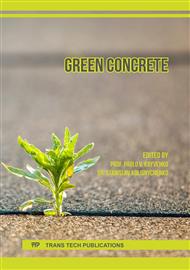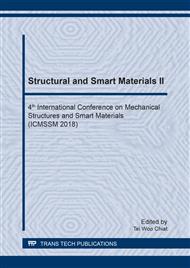[1]
F. Sanchez, K. Sobolev, Nanotechnology in concrete–a review, Constr. Build. Mater. 24 (11) (2010), p.2060–(2071).
Google Scholar
[2]
R. Madandoust et al., An experimental investigation on the durability of self-compacting mortar contains nano-SiO2, nano-Fe2O, and nano-CuO, Constr. Build. Mater. 86 (2015), p.44–50.
DOI: 10.1016/j.conbuildmat.2021.124713
Google Scholar
[3]
E. Mohseni et al., Microstructure and durability properties of cement mortars containing nano-TiO and rice husk ash, Constr. Build. Mater. 114 (2016), p.656–664.
DOI: 10.1016/j.conbuildmat.2016.03.136
Google Scholar
[4]
R.B. Ardalan, A. Joshaghani, R.D. Hooton, Workability retention and compressive strength of self-compacting concrete incorporating pumice powder and silica fume, Constr. Build. Mater. 134 (2017), p.116–122.
DOI: 10.1016/j.conbuildmat.2016.12.090
Google Scholar
[5]
G. Land, D. Stephan, The influence of nano-silica on the hydration of ordinary Portland cement, J. Mater. Sci. 47 (2) (2012), p.1011–1017.
DOI: 10.1007/s10853-011-5881-1
Google Scholar
[6]
T. Ji, Preliminary study on the water permeability and microstructure of concrete incorporating nano-SiO, Cem. Concr. Res. 35 (10) (2005), p.1943–(1947).
DOI: 10.1016/j.cemconres.2005.07.004
Google Scholar
[7]
B. H. Xie et al., Experimental Study on the Compressive Strength of Nano-Concrete,, Applied Mechanics and Materials, Vols. 584-586 (2014), pp.1563-1567.
DOI: 10.4028/www.scientific.net/amm.584-586.1563
Google Scholar
[8]
M. H. Zhang et al., Mechanical Property of Pavement Concrete with Nano-Particles,, Advanced Materials Research, Vols. 168-170(2011), pp.1896-1899.
DOI: 10.4028/www.scientific.net/amr.168-170.1896
Google Scholar
[9]
R.H Lumingkewas, H. Purnomo, G. Ausias, T. Lecompte, A. Perrot, D. Priadi, I. Katili, Properties of Indonesian coconut fibers for cement-based materials reinforcement, Proceeding, Third International Conference Natural Poly, Bio-Mat, and Gels (ICNP-2012), Kottayam, Kerala, India, (2012).
DOI: 10.4028/www.scientific.net/amr.742.92
Google Scholar
[10]
R.H. Lumingkewas et al., Effect of fibers content on the tensile properties of coconut fibers reinforced cement mortar composites, Adv Mat Res, Vol. 742 (2013), pp.92-97.
DOI: 10.4028/www.scientific.net/amr.742.92
Google Scholar
[11]
RH. Lumingkewas et al., Tensile characteristics of coconut fibers reinforced mortar composites, Advanced Materials Research, 651 (2013), pp.269-273.
DOI: 10.4028/www.scientific.net/amr.651.269
Google Scholar
[12]
R.H Lumingkewas et al., Effect of Fibers Length and Fibers Content on the Splitting Tensile Strength of Coconut Fibers Reinforced Concrete Composites. Key Eng.Mat. Vol. 748 (2017), pp.311-315.
DOI: 10.4028/www.scientific.net/kem.748.311
Google Scholar
[13]
H. Purnomo et al., Effect of Coconut Fibers Addition to Early Age Unfired Soil-Lime Bricks Strength. Key Eng.Mat. Vol. 594 (2014), pp.471-476.
DOI: 10.4028/www.scientific.net/kem.594-595.471
Google Scholar
[14]
RH. Lumingkewas, R Setyadi, R Yanita, S Akbar, A.H Yuwono: Tensile Behavior of Composite Concrete Reinforced Sugar Palm Fiber. Key Eng.Mat. Vol. 777 (2018), pp.471-475.
DOI: 10.4028/www.scientific.net/kem.777.471
Google Scholar
[15]
Asasutjarit C, Charoenvai S., Hirunlabh J, Khedari J: Materials and mechanical properties of retreated coir-based green composites, Composites: Part B, 40 (2009), p.633–637.
DOI: 10.1016/j.compositesb.2009.04.009
Google Scholar
[16]
Onuaguluchi O., Banthia N: Plant-based natural fiber reinforced cement composites: A review, Cement and Concrete Composites, Vol. 68 (2016), pp.96-108.
DOI: 10.1016/j.cemconcomp.2016.02.014
Google Scholar



